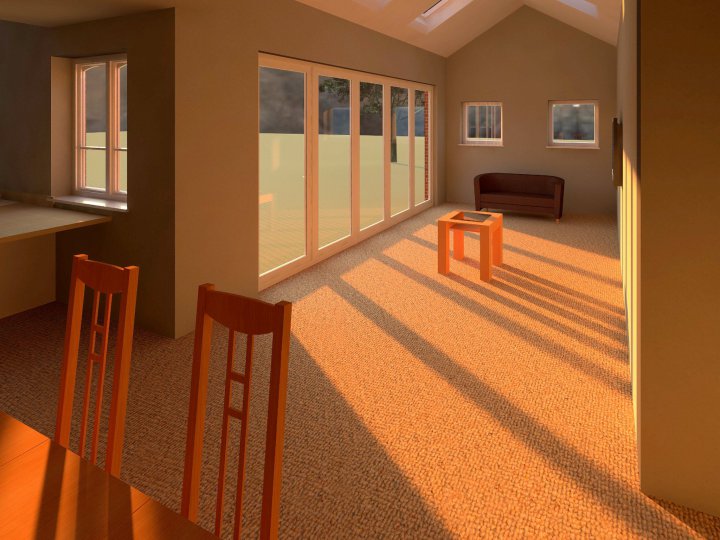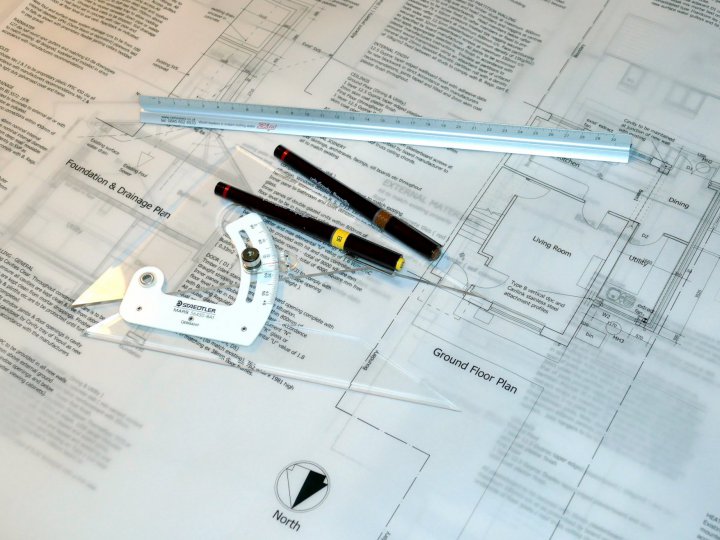
Flat roofs have suffered from a somewhat poor reputation in the past and are still viewed by many clients as something to be avoided.

This view is not unjustified even though most issues arise through ill-considered design and/or poor on-site workmanship but modern materials, certified installers and far stricter building regulations mean that modern flat roofs are a far cry from the leaky slapdash versions from the 1970’s and 1980’s.
Today a flat roof with an integrated lantern window light hidden behind a parapet wall detail can be a very elegant and cost-effective roofing solution.
Contrary to its description, a ‘flat’ roof should be anything but flat. Instead, they should be laid and installed with a very shallow gradient or fall to one side (typically between 1:40 to 1:60) to ensure that any rainwater drains away from the roof.
The most common sign that a flat roof has been built incorrectly is pooling water on the top of the roof following heavy rain. If your property does have a problematic flat roof, a complete replacement will likely be more cost effective in the long term than any localised repair.

How Are Flat Roofs Constructed?
Flat roofs are typically constructed to create either a ‘warm roof’ or ‘cold roof’ depending on the requirements of the project, site conditions as well as the applicable building regulations but like any construction, the design and on-site building of any flat roof must be exact if it is to last.
A ‘warm’ flat roof is now by far the most common method of construction for homes in the UK. This has its insulation placed above the timber structure which in turn keeps the timber elements warm. Then ‘firring’ battens, which are simply small angled timber strips are fixed over the rafters to create the necessary slight pitch onto which a timber deck and waterproof membrane is laid and fixed. Another option is to cut the required fall directly into the roof insulation panels, this is referred to as ‘tapered’ insulation.
A ‘cold’ flat roof has its insulation placed between the timber rafters and/or under the plywood roof covering leaving the timber rafters somewhat more exposed to colder temperatures. This was the standard method used in the 1970’s & 1980’s but is seldom used for either new-builds or refurbishments today.
Another option that has emerged in recent years are ‘inverted’ flat roofs where the insulation is placed above the waterproof covering but this method is very rare in the UK. Concrete slab flat roofs can also be used. A concrete slab is finished with a smooth screed with a waterproof membrane laid on top and a vapour control layer to protect from condensation.
There are multiple material and installation options available for the finishing top layer of flat roofs including spray-on options which eliminate most roofing seams. These include multi-layer torch-on felt systems, EPDM Elastomeric systems (ethylene propylene diene monomer), GRP Fibreglass systems (glass reinforced polyester) or a huge variety of suspended timber decking, stone slab or tile finishes where the flat roof is used as a balcony.
Ventilation requirements for flat roofs are outlined in detail in The UK Building Regulations Approved Documents C & F, The Scotland Technical Handbook - Section 3 and British Standard BS-5250 (Control Of Condensation In Buildings).
For ‘cold’ flat roofs a minimum 50mm air ventilation gap is required between the insulation and roof decking. This is to prevent condensation forming in any unvented void (known as ‘interstitial’ condensation), where moisture is formed when warm air encounters any cold surface which can rot the roofs timber structure from the inside out. However, another advantage of modern ‘warm’ flat roofs is that they are effectively sealed and do not require ventilation. It must be noted this is also a potential issue with poorly specified or badly constructed pitched roofs and is not an issue inherent only to flat roofs.

What Are Living Green Roofs?
A new and increasing popular option that has emerged in recent years are ‘green’ or ‘living’ roofs as they represent a sustainable solution for flat roofs and if done correctly, can make a spectacular and eco-friendly feature, particularly on large flat roofs.
However, they will likely require the specification for the main roof structure to be changed or reinforced as any green roof will add a significant amount of additional weight to the roof.
Living roofs also must include a root barrier layer to prevent any vegetation, flowers, grasses, mosses or other planting coming into contact with the waterproofing membrane beneath but in turn, this can significantly aid in reducing rainwater runoff as it will be absorbed and used by the planting on the roof instead of simply flowing into any drainage channels.
With so much conflicting information available online regarding flat roofs, for a no obligation discussion of your architecture and construction needs, please contact IGB Architectural Design using the form below.
